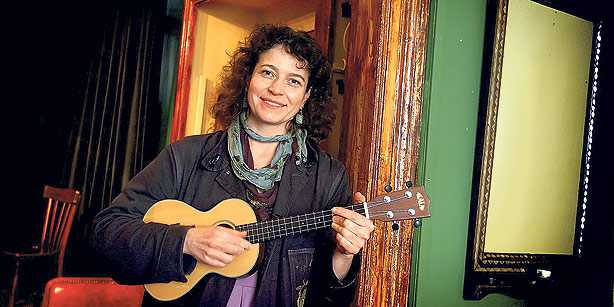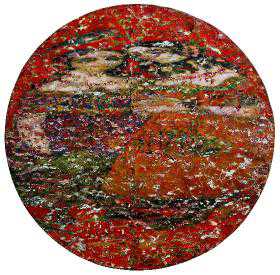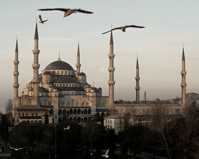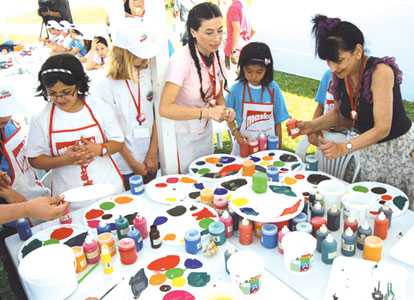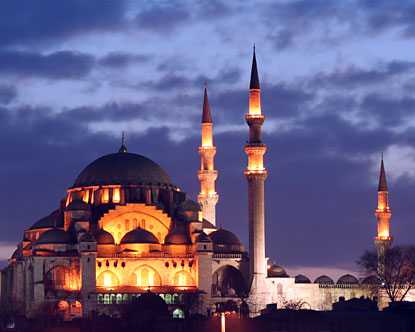Cancelling clichés: Alexandra Klobouk says that if you grow up in Germany, you know next to nothing about Turkey. Now, with her book, the young graphic designer has created a counterpoint to Germany’s current debate on immigrants. A portrait by Nina Apin
A humorous book “for everyone who has no idea either”: Cover of Alexandra Klobouk’s Istanbul, mit scharfe Soße?She meant to make a real Turkish breakfast, Alexandra Klobouk apologises as soon as she opens the front door. In the kitchen of her shared flat on Berlin’s hip Kastanienallee – mix ‘n’ match furniture, cleaning rota on the wall – there are fruit and biscuits on the table. The only Turkish thing in the room is a blue glass ornament on the fridge, warding off the “evil eye”.
She didn’t have enough time, Klobouk calls over her shoulder on the way to make coffee, and time is the main ingredient for proper “menemen”. The 27-year-old graphic designer reaches for a book on the kitchen table, using one of the illustrations to show me the many variations on Turkish scrambled eggs: with chopped peppers, garlic sausage, sheep’s milk cheese, and tea on the side… Her hands skip across the pages, following the arrows, demonstrating how to make Turkish tea.
Total ignorance concerning Turkish people
A typical stereotype of Turkish culture: women who want to lead independent lives get murdered in honour killingsThe illustrations are Klobouk’s own work, the chapter on breakfast and tea culture is from her book “Istanbul, mit scharfe Soße?” (“Istanbul, with hot sauce?”) The title illustration shows a young woman riding across the Bosporus on a kebab spit. “If you grow up in Germany,” Klobouk explains the picture, “you know next to nothing about Turkey.” Kebab chefs, women in headscarves and footballers – that’s about the extent of it. The rest, she says, is secondary knowledge – media reports on “honour killings”, forced marriages and under-educated parallel societies.
The slim volume brought out by the tiny independent publishers Onkel & Onkel is the result of an irritation. Alexandra Klobouk had seen Fatih Akin’s film Crossing the Bridge, a documentary about the music scene in Istanbul. “I was really impressed. And horrified by how little the images on the screen had in common with the ones in my head,” she says. She’d always thought of herself as a cosmopolitan – “but after seeing the film, I had to admit how much the clichés of Turkish people from the German detective series had influenced my perception.”
Subtle strokes
You can still tell how shocked Klobouk was about herself, even now. She devotes the first chapter of her bilingual book to common prejudices: women in veils lugging heavy shopping bags behind their moustachio’d husbands, a concrete monstrosity by the name of “Antalya Beach Paradise” awaiting German holiday-makers. Her reduced illustrations hint at a great deal with subtle strokes, while the rest takes place inside the reader’s head.
Time is the main ingredient for a proper Turkish repast… Graphic designer and author Alexandra Klobouk moved to Istanbul for seven months, knowing nothing about the Turkish language, the country or the city itselfKlobouk grew up in Regensburg, Bavaria; her parents are artists. None of the students at her grammar school came from Turkish families. And even when Klobouk moved to Berlin seven years ago to study communication design, her contact to the city’s large ethnic Turkish population remained at a minimum: the unfriendly greengrocer on the corner, loud young men on the train. And of course the media reports.
Her eyes opened by Akin’s film, Klobouk decided to get an impression of her own, flying to Istanbul for three weeks. Her original goal was to establish an exchange programme between her art school and a Turkish university. “Looking back, my approach was probably rather naïve,” laughs Klobouk. “I didn’t speak a word of Turkish and I’d underestimated the bureaucracy.” In the end, however, she managed to exchange universities with a graphic design student in Istanbul.
Getting used to Turkish hospitality
She then spent seven months in the city. She attended Marmara University in the Asian part of Istanbul and moved in with another student, who spoke about as little English as Klobouk spoke Turkish. “I didn’t understand a thing,” says Klobouk, miming absolute helplessness, “but I got help from all over from the very first day.”
Scanning the veil: According to Alexandra Klobouk, first impressions can be deceivingKlobouk soon found herself integrated into a network of young women, all of whom studied and partied together, and celebrated long drawn-out breakfasts every Sunday in their flat. “Everyone talked and I just listened – and every quarter of an hour someone gave me a summary of the conversation.”
Thanks to this effective language-learning method, she was soon able to go shopping at the market, “and to tell a Turkish mother how wonderful her cooking was.” There were plenty of opportunities to do so. It took Klobouk a while to get used to Turkish hospitality, which forbids guests from lifting a finger. And there was more to get accustomed to: the group taxis, the street children, the bureaucracy, the ever-present police. During her stay, major terrorist attacks shook the city, the worst of them killing 17 people. The book shows a woman on an underground train pressing her backpack to her body as protection from nail bombs.
No, Alexandra Klobouk doesn’t want to live in Istanbul for good. “You see too much in seven months to be 100% enthusiastic,” is her sober comment. Klobouk talks about her best friend Duygu. Wearing short trousers was perfectly normal in her hometown of Izmir – but in Istanbul they incensed the rural population originally from Anatolia, which has been bringing conservative influences into the previously very Western city for some years now.
Self-appointed “guardians of virtue”
Not one to boast: the young graphic designer Alexandra KloboukIs Istanbul becoming a Muslim city? Klobouk shrugs: “I only got to know a very small section of Turkish society. Nobody I know wears a headscarf or goes to mosque.” Yet her female friends felt they had to justify their way of life, smuggling male visitors past self-appointed “guardians of virtue” in their buildings.
Our kitchen-table conversation is approaching Germany’s current debate on integration. Alexandra Klobouk sighs. She came across the former politician who launched the debate, Thilo Sarrazin, at the Frankfurt Book Fair. “I really ought to thank him; my book is suddenly highly topical thanks to his insulting comments on immigrants.” But she has no wish to engage with the arguments of the likes of Sarrazin and the Bavarian conservative Horst Seehofer. Klobouk, not one to boast, tells me she is a little proud to have created a counterpoint to the ubiquitous Turk-bashing in Germany right now.
Nina Apin
© Tageszeitung/Qantara.de 2010
Translated from the German by Katy Derbyshire
Editor: Lewis Gropp/Qantara.de
 Turkish Mystic Sufi musician Latif Bolat will present music, poetry, Sufi mystic stories and images from the ancient land of Turkey at the New York Mills Regional Cultural Center at 7:30 p.m. on Thursday, Nov. 18. Tickets are $12 advance sale and $15 at the door. Student tickets are $5 anytime.
Turkish Mystic Sufi musician Latif Bolat will present music, poetry, Sufi mystic stories and images from the ancient land of Turkey at the New York Mills Regional Cultural Center at 7:30 p.m. on Thursday, Nov. 18. Tickets are $12 advance sale and $15 at the door. Student tickets are $5 anytime.
